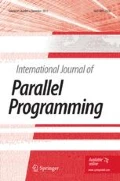Abstract
The multicluster architecture that we introduce offers a decentralized, dynamically-scheduled architecture, in which the register files, dispatch queue, and functional units of the architecture are distributed across multiple clusters, and each cluster is assigned a subset of the architectural registers. The motivation for the multicluster architecture is to reduce the clock cycle time, relative to a single-cluster architecture with the same number of hardware resources, by reducing the size and complexity of components on critical timing paths. Resource partitioning, however, introduces instruction-execution overhead and may reduce the number of concurrently executing instructions. To counter these two negative by-products of partitioning, we developed a static instruction scheduling algorithm. We describe this algorithm, and using trace-driven simulations of SPEC92 benchmarks, evaluate its effectiveness. This evaluation indicates that for the configurations considered, the multicluster architecture may have significant performance advantages at feature sizes below 0.35 μm, and warrants further investigation.
Similar content being viewed by others
REFERENCES
R. E. Kessler, The Alpha 21264 Microprocessor, IEEE Micro. 19(2):24–36 (1999)
Kenneth C. Yeager, The MIPS R10000 Superscalar Microprocessor, IEEE Micro. 16(2):28–40 (1996).
Keith I. Farkas, Memory-system Design Considerations for Dynamically-scheduled Microprocessors, Ph.D. thesis, Department of Electrical and Computer Engineering, University of Toronto, Ontario, Canada (January 1997). (URL: http://www.research.digital.com/wrl/ people/farkas/papers/thesis_phd.html)
James E. Smith, Decoupled Acess/Execute Computer Architecture, Proc. Ninth Int'l. Symp. Computer Architecture, pp. 112–119 (1982).
P. Geoffrey Lowney, Stefan Freudenberger, Thomas Karzes, W. D. Lichtenstein, Robert P. Nix, John S. O'Donnell, and John C. Ruttenberg, The Multiflow Trace Scheduling Compiler, J. Supercomputing 7( 1,2):51–142 (May 1993).
Gurindar S. Sohi, Scott E. Breach, and T. N. Vijaykumar, Multiscalar Processors, Proc. 22st Int'l. Symp. Computer Architecture, pp. 414–425 (1995).
Dean M. Tullsen, Susan J. Eggers, Joel S. Emer, Henry M. Levy, Jack L. Lo, and Rebecca L. Stamm, Exploiting Choice: Instruction Fetch and Issue on an Implementable Simultaneous Multithreaded Processor, Proc. 23rd Int'l. Symp. Computer Architecture, pp. 191–202 (May 1996).
Basem A. Nayfeh, Lance Hammond, and Kunle Olukotun, Evaluation of Design Alternatives for a Multiprocessor Microprocessor, Proc. 23rd Int'l. Symp. Computer Architecture, pp. 67–77 (May 1996).
Alfred V. Aho, Ravi Sethi, and Jeffrey D. Ullman, Compilers, Principles, Techniques and Tools, Addison-Wesley Publishing Company, Reading, Massachusetts (1986).
Preston Briggs, Keith D. Cooper, and Linda Torczon, Improvements to Graph Coloring Register Allocation, ACM Trans. Progr. Lang. Syst. 16(3):428–455 (May 1994).
Amitabh Srivastava and Alan Eustace, Atom: A System for Building Customized Program Analysis Tools, Proc. ACM SIGPLAN Conf. Progr. Lang. (March 1994).
Keith I. Farkas and Norman P. Jouppi, Complexity/Performance Tradeoffs with Non-Blocking Loads, Proc. 21st Int'l. Symp. Computer Architecture, pp. 211–222 (1994).
Scott McFarling, Combining Branch Predictors, DEC WRL Technical Note TN-36 (1993).
Subbarao Palacharla, Norman P. Jouppi, and James E. Smith, Complexity-Effective Superscalar Processors, Proc. 24th Ann. Int'l. Symp. Computer Architecture, pp. 206–218 (1997).
Pohua P. Chang, Scott A. Mahlke, William Y. Chen, Nancy J. Warter, and Wen-mei W. Hwu, IMPACT: An Architectural Framework for Multiple-Instruction-Issue Processors, Proc. 18th Ann. Int'l. Symp. Computer Architecture, pp. 266–275 (1991).
Rights and permissions
About this article
Cite this article
Farkas, K.I., Chow, P., Jouppi, N.P. et al. The Multicluster Architecture: Reducing Processor Cycle Time Through Partitioning. International Journal of Parallel Programming 27, 327–356 (1999). https://doi.org/10.1023/A:1018782806674
Issue Date:
DOI: https://doi.org/10.1023/A:1018782806674




